1/2 King Street, Ludlow, Shropshire
So we're doing magazines now are we? Well yes, obviously. The tagline of this blog is "seeking out Britain's pioneering software houses," but I've covered Argus Specialist Press and assorted computer manufacturers under the fig leaf justification that those companies did occasionally chuck out a few games. I could have done the same for Newsfield because they spun off a software house called Thalamus but it seems unnecessary. Newsfield were an essential part of the UK software scene in their own right, as were other publishers like Future (AMSTRAD ACTION) or Sportscene/Dennis (YOUR SINCLAIR and YOUR 64), or hardware companies like Romantic Robot (the various Multiface machines) and joystick kings Konix. A whole support industry grew up around software companies like the ecology of a coral reef and to not talk about it is to not tell the whole story.
Also, I've always wanted to visit Ludlow.
If you asked me as a kid what I job I wanted, the answer would usually depend on what I'd just watched on television. I watched All Creatures Great and Small and I wanted to be a vet. I watched Juliet Bravo and I wanted to be a police officer. I watched Battle of the Planets, I wanted to be an orphan with superpowers. That all changed once I'd read CRASH. After that there was only one possible answer forever. I wanted a job working for a computer magazine. It never happened although there were a couple of near misses[1].I couldn't tell you why CRASH had such an impact on my life except that it came along at the right time. My parents had brought me (and my brother, I suppose) a ZX Spectrum in the autumn of 1984 when I was just about to enter my teens. I picked up issue 13 and it was the start of an obsession. Some people read SMASH HITS and follow pop groups. Some people support a football team and read SHOOT. Some people collect stamps and read GIBBONS STAMP MONTHLY. Why does anyone do the things they do?
Oliver's brother Franco had been trying to source Spectrum games for a German company and found it difficult because at the time games were not readily available in UK shops either. He approached Roger and Oli, and the three of them began to buy games directly from software publishers to sell via mail order. A nine page catalogue was produced, Roger typed up short reviews and Oli drew the cover and internal illustrations. There's a beautiful archive at CRASH online and I want to refer you there rather than duplicate all the hard work which has gone into that site.
This entry is going to be odd. It's going to talk occasionally about emotions, for which I apologise in advance. This trip to Ludlow had a much more personal effect on me than I expected. Just sitting here writing this has stirred up the same feeling again, up, an odd stew of nostalgia that I feel in my gut more than my head. It doesn't make a lick of sense. I enjoyed working for Virgin Interactive Entertainment but I'm not nostalgic for those days. Instead I'm nostalgic for people I never knew and a place I didn't visit until 2023. That's a year after Oliver Frey died in August 2022, followed by his partner Roger Kean in January 2023. I never met either of them but I miss them. Their deaths are two of the few occasions when I've mourned the death of a stranger; Rik Mayall and Oliver Postgate being two others. The art Oliver Frey drew and the words Roger Kean wrote and edited had a significant and positive effect on me. I absolutely wouldn't be sitting here writing this if I hadn't picked up issue 13 of CRASH in 1985. I wouldn't have made my unsuccessful (but fun) forays into the computer game industry. I wouldn't have cranked out a lot of unpaid writing. I wouldn't have had a go at editing my own fanzine. All that happened because I picked up that issue of CRASH with the eerie cover that caught my eye in the Hempstead Valley WH Smith[2]. I took it home and read it cover-to-cover, and then I read it again and again and again. I don't have that issue any more. It fell apart long ago like some sort of metaphor. I would have loved to meet Roger and Oli and tell them how much their work meant to me but I never had the chance. This is, kind of, a relief given I once met Louise Jamieson, Leela from Doctor Who, in a corridor (how ironic) and my panicked opening conversational gambit was "I've seen you on television!"
Oliver Frey and Roger Kean moved to Ludlow in 1982. They had worked since 1978 with photographer and film-maker Alan Purnell at a company called Street Level who published HIM magazine and other gay erotica. By 1981 Oliver's work was well known enough for him to be interviewed on LWT's Sunday late night programme Gay Life.
 |
| DAILY MIRROR Saturday 27th June 1981 |
There's a website about Oliver Frey's gay erotica called zack-art.com (NSFW), it describes what happened next:
Police from the Obscene Publications Squad marched into Street Level’s premises in 1982 and seized all stock and work in progress.
The matter never came to court, but the loss of so much stock and future publications wrecked the company. Purnell having left some months before, Frey and Kean sold the rights in all the titles to Millivres, publishers of HIM rival, Zipper. It was the start of a new era.
Doctor Who showrunner Russell T. Davies name-checked Oliver Frey when speaking to THE GUARDIAN (3 January 2021) in advance of the broadcast of his series It's a Sin, as he recalled the early days of the Aids epidemic:
I can remember the exact moment I took it seriously for the first time. June 1983, I was a student in Oxford. I went to buy milk, 20 Bensons, and my proud passport into adult life, the monthly copy of Him magazine. Except I wasn’t that proud and shuffled it under a copy of the Mirror. I didn’t actually look at it until I was walking home. And I stopped. Right there. On Juxon Street. Blazing sunshine. I stared at the headline. “Aids Gay Death-Plot Panic.” The words emblazoned across a brilliant and erotic drawing of naked men boiling to death in a test tube, drawn by the artist Oliver Frey.
Oh, I thought, it’s real. That story. It’s true.
I wonder if that magazine saved my life.
CRASH MICRO, Freepost, Ludlow, Shropshire, SY8
(Really: 85 Old Street, Ludlow)
(Really: 85 Old Street, Ludlow)
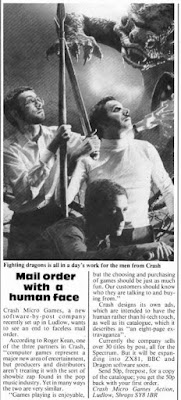 |
| HOME COMPUTING WEEKLY July 19-25 1983 page 5 |
CRASH Online archives three catalogues which they name May/June 1983, mid 1983, and late 1983. These names are based on dates given by Roger Kean to CRASH online:
We started the mail order operation in about May/June 83 and began work on getting the first Crash magazine in October (originally aiming for a Christmas issue out in early December 83, which, as we all know, we missed!), by which time there was no more time for the catalogues! So roughly speaking, one catalogue every 5 to 6 weeks.
Crash Micro put out a press release: "For immediate release, Weds. 3rd June 1983." The press release is up on the CRASH magazine Twitter feed, @CrashOnlineUK. A couple of computer magazines turned it into a news story. There's the HOME COMPUTING WEEKLY one pictured here. The same photo, poorly cropped to remove Oliver Frey, is also used in a PERSONAL COMPUTER NEWS report (July 14-July 20 1983 page 8) and both stories use the press release "faceless mail order" comment.
The fighting dragons picture was one of three sent out with the Crash Micro press release. On Roger Kean's Facebook page he described it as: "Photographed in the hall of 85 Old Street, Ludlow, with overpainting on the photo print by Oliver Frey." The second picture of the set showed the trio facing into the camera and blasting the reader with what the press release called: "Quad photon phaser lasers on full zap." This picture really reminds me of the photo comic strip Doomlord which premiered in 1982, in the first issue of the relaunched Eagle. Pretty much weekly the alien Doomlord "servant of Nox, master of life, bringer of death," would use his mysterious ring to dispose of some unfortunate while setting his "energiser to disintegrate!" Oliver Frey would go on to draw Dan Dare for the Eagle in 1983.
I don't have a photo of the hall inside 85 Old Street because I'm not a lunatic. However the third photo on the press release was taken outside, on Broad Street, Ludlow.
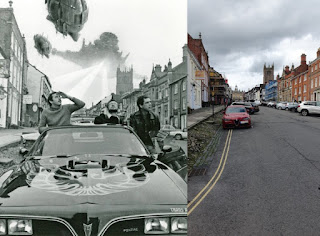 |
| June1983 & September 2023 |
I stayed overnight at the Wheatsheaf pub in Ludlow and Broad Street was the first place I stumbled across. I left the pub, on Lower Broad Street and walked through Broad Gate, which looks like something dropped in from Ankh-Morpork. I was immediately looking at the view from the photograph. Minus a giant car and alien spaceships, surprisingly. By my guess the red car in my photo is parked roughly where everyone posed around Franco Frey's left-hand drive Trans-Am 40 years previously. This was also when I began to realise that Ludlow is not a big town. At the top of the hill you can just about make out a sandy coloured building, that's the Buttercross which stands at the entrance to King Street.
What's the timeline of the Crash Micro catalogues? The one CRASH Online calls mid 1983 can I think be pretty precisely dated because it includes a competition with a closing date of 20th September 1983. The catalogue clearly wasn't intended to stay in print much after that date. The same catalogue also includes a proto-editorial welcoming readers to:
...our second catalogue in only two months, demand for the first was so great, and it is twice the size of the first. If you would be interested in received our third, further expanded catalogue/magazine, please let us know.
Private Eye sold for 40p in 1983, is this how CRASH could have looked? The outofprintarchive.com article confirms Roger Kean's thoughts were heading in that direction.
To give you some idea of how fast all this was moving, Newsfield was aiming to publish the first issue of CRASH on 18th November to catch the Christmas software market. At 1983 printing speeds, the content for all 112 pages would need to be ready by around the end of October. These pages would be written by Roger Kean, Oliver Frey, and Franco Frey. The same team of three who were also trying to raise funds, sell advertising, and keep the mail order business going. For those of you wondering about the other staff writers credited on that first issue, Roger Kean has some bad news in Eurogamer's feature The Story of Crash Magazine:
Remember that competition in the mid 1983 catalogue. The prize draw to be made on Saturday 24th September 1983 by the chairman of the Ludlow Computer Club, Commander Locke. The competition text promised the winners names would be printed in the next issue of YOUR COMPUTER following the draw. That issue would have been November 1983 but the results don't appear in YOUR COMPUTER. Instead CRASH issue one names the winners, alongside a photo doctored in the house style of the catalogue to show the Chairman of the Ludlow Computer Club being attended to by aliens. I wonder if this is a clue that the bulk of issue one was written with an 18th November publication date in mind. It would make sense for the first issue of CRASH to carry the winners instead of YOUR COMPUTER but the delay meant they had to wait.
LM had an unusual dual cover. The plain orange outer cover which opened to reveal a more standard Oliver Frey painting. I like it. It would have stood out like a beacon on the shelves. But, I'm not in publishing. Julian Rignall, who wrote for ZZAP from issue one and would become editor from December 1987 recalled on Twitter:
Option 2: Build somewhere:
The June 1989 issue was also when Oliver Frey became editor. A Monkey's Paw appointment; congratulations you're editing the magazine you've worked on for five years but there's only enough money for 36 pages. Oli was still editor in June 1990 when the decision was made to advertise CRASH and ZZAP!64 in EAGLE. Following a comment by Scott Hood on Facebook, I was able to track down the advert.
The news came late enough in the production cycle that the news pages had to be ditched in order to squeeze in a double-page spread. The March 1992 issue of SINCLAIR USER is pictured and was presumably in the shops at the time, it was on sale between February 18th to March 18th. There was just enough time to put together a quick double-page memorial poster with the dates 1984-1992. The CRASH logo stayed on the front cover of the next six issues of SINCLAIR USER getting smaller, and smaller, and smaller, before it finally vanished.
The following year (September 1986 page 73), the CRASH team actually managed to get properly outside and trekked all the way down Market Street to Ludlow Castle to capture this picture of programmer Dave Perry being menaced by Mikro-Gen's Wally Week in the old doctored photo style.
The location of this climbing frame where two cool dudes modelled CRASH shirts and hats remains elusive. Linny Riverside Park? Possibly.
Joysticks were a good way to get better control of games but, unlike the Commodore, the Spectrum had no built in joystick port. Spectrum owners instead needed to buy a joystick interface which plugged into the back of the Spectrum and then the joystick plugged into the interface. Interfaces came in different formats because every company hoped theirs would become the standard, and they all had different ways of accepting the joystick input. The Sinclair Interface 1 and the follow up device, which Sinclair named the Interface 2 after much midnight oil burning, both used cursor keys; the Kempston interface (by far the most popular) used a function of the Spectrum's code called IN 31; another company called Protek used a different function, IN 127. Franco Frey put on his engineer's hat and designed an alternative called the Comcon which he sold through (presumably) his own company called Frel Ltd (company number 01706581 incorporated 15 Mar 1983 and dissolved 28 Sep 1999). The Comcon was advertised in CRASH from May 1984 to around April 1987. The business address remained the same, Hockeys Mill, Temeside, Ludlow, and as far as I can tell this was where Franco Frey lived. The Geograph website has a photo of the building with the note that it was "converted to housing in 1977." The location is idyllic, right on the bank on the river Teme by the huge U-shaped wear, and only a short distance from the Ludford bridge. However because it's someone's house, I'm not including a photo.
Research House has the advantage of being easy to find and still obviously existing. The office got a write-up in the second issue of NEWSFEEL.
Working on Roger Kean's suggestion that each catalogue was intended to cover a five to six week period, let's assume it was released at the start of August. Working backwards, in order to fit two catalogues into two months, the first catalogue (the one called May/June) must have been ready to go from the start of late June at the earliest. The next six month period from July to December 1983 would be packed:
One day I took a phone call from the managing director of magazine distributors Wells, Gardner & Darton. His young son, it seemed, had received one of our catalogues. Intrigued, he’d shown it to the news buyer of WH Smith in Swindon, who told him that if this black and white rag turned into a real magazine, WH Smith would certainly stock it in all its stores.
I don't know when this phone call took place but the design of the mid 1983 catalogue makes it clear Roger and Oli's thoughts are already toying with the idea of turning the catalogue into a magazine. The first two catalogues share the same cover art but the mid 1983 one has been made a bit more magazine-like with cover text and a strap line. The second catalogue also reads more like a magazine; there's the short editorial on page two, the contest on page 13, and some revealing text on the page 14 order form:
It would also help us if you would tick the appropriate box at the top of the form indicating whether you would be interested in a fill scale magazine devoted to game reviews for the Spectrum. This would have 40 pages monthly at a cost of 40p.
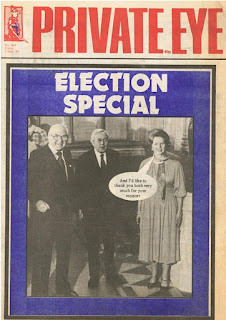 |
| 3 June 1983 |
Private Eye sold for 40p in 1983, is this how CRASH could have looked? The outofprintarchive.com article confirms Roger Kean's thoughts were heading in that direction.
Our first plan was to keep the price very low, about 35p, and print on newsprint, with only a colour cover, but Smiths weren't happy with such a low cover price and insisted on a minimum of 75p. But that meant they wanted more colour pages inside to support the higher price, and that's what happened. Unfortunately, it put up our production costs, since scanning colour back in the early 1980s was not a cheap option.
Roger and Oli began to develop the new magazine while running a successful mail order business with Franco. Again, the CRASH online archive has some remarkable material; rough drafts of the logo and cover, and Oliver Frey's costings for a magazine with a circulation of 40,000 selling at 60p and 75p. The CRASH archive dates these costings to August 1983 followed by Roger Kean's later more detailed calculations in September. Much later, October 1987, the CRASH History included Lloyd Mangram's memories of the development period:
At the 1983 PCW Show, held at the Barbican that year, Roger Kean and CRASH financial director Franco Frey roved around the stands trying to convince software houses that a really new magazine was about to arrive. Interest was generally luke warm, but nevertheless, by mid- December when the issue had to be ready, 27 pages of advertising had been sold -enough to provide CRASH with the funds to print!
Roger's CRASH issue one editorial included this brief description of that lukewarm reaction:
The spokesman for another very well known software house told me at the PCW show recently that he had 'heaved' when he saw the details sent him by CRASH and went on to explain that his company's games have 'honest covers'. It transpired that he disapproved of trying to con people with exciting artwork that has little to do with the quality of graphics contained in the programs available, and our intention of having plenty of exciting artwork in the magazine was basically dishonest, But what seemed uppermost in his mind was the fear that reviewers didn't understand his games or play them well enough to be able to review them fairly. He told me he wouldn't be releasing review copies of new games until he could write the reviews himself.
The 1983 PCW Show ran from Thursday 29th September to Sunday 2nd October. Three days later, on Wednesday 5th October, Newsfield was born. Back to the retrovideogamer.co.uk interview:
The three of us needed a limited liability company to continue operations. It was all very well-being a partnership in the purchase and reselling of cassettes, but the levels of continual funding required to print real magazines and distribute them was scary. We purchased an off-the-shelf company in the early summer of 1983. These are sold for £100 by specialist firms of solicitors, and each company is given a typical, though unique, ‘off-the-shelf’ name – ours happened to be called Newsfield Limited and we never changed its name to something more suitable because it was about news and we certainly lived in a field compared to all our soon-to-be London-based competition.
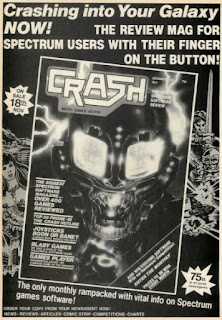 |
| YOUR COMPUTER November 1983 page 160 |
One thing I learned in London was that a magazine isn't credible unless it has a sizeable masthead. That first issue only had the three of us, so we needed to add more staff." Kean's solution was the nom de plume of Lloyd Mangram, named after Texan golfer Lloyd Mangrum. Rod Bellamy [3], a staff writer in the first three issues, was also fictitious. As Crash blossomed, real contributors replaced the fake ones, but Mangram remained as a stalwart of the magazine, right until its very end.
Starting at the top of the page, the logo remains the same but the cover date changes. It is December 1983 in the YOUR COMPUTER advert. January 1984 in the catalogue. Then February 1984 on the final cover; when someone remembers that's the correct on sale month for a magazine published in January. Most of the cover text remains the same but Blaby games lose their front page spot, replaced by The Wrath of Magra which becomes the first game mentioned on a CRASH cover. The "GAME PLAYER" line is dropped from the bottom of the cover, someone has realised that "SHOOT EM UP!" fits better with the artwork. The text on the diagonal bar is also snappier on the final cover.
Something had to give and that something was the publication date which was pushed back to Friday 13th January 1984. This is where the last Crash Micro catalogue comes in, the one referred to as late 1983. It's clearly designed to cover the period between November 18th and Friday 13th January; in fact it reads more like CRASH issue zero than the last Crash Micro catalogue. If my timeline is right, there's a gap; The May/June 1983 catalogue is actually more like June/July 1983. Mid 1983 covers August and September. Finally, there is the late 1983 catalogue for December 1983 and January 1984. A third catalogue would fit very nicely into that October to November hole. Did it exist? Was there time to produce one in the flurry of activity? Does it still exist somewhere? Check your lofts people!
We have three variants of the CRASH issue 1 cover; the one from the YOUR COMPUTER advert, another in the late 1983 catalogue, and the real thing. Putting them side by side reveals a few minor differences.
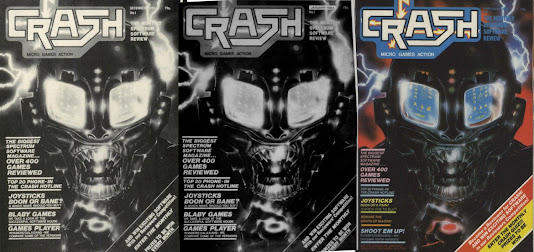 |
| Left to right: YOUR COMPUTER advert, late 1983 catalogue, and Issue 1 |
 |
| CRASH February 1984 page 26 |
CRASH issue one hit the shelves as planned on Friday 13th January and began a remarkable magazine run.
CRASH, PO Box 10, Ludlow, Shropshire SY8 1DB
(Still: 85 Old Street, Ludlow)
(Still: 85 Old Street, Ludlow)
CRASH's editorial address was hidden behind the anonymity of a PO Box for the first six issues. This helped make CRASH appear more creditable and also concealed that the magazine was operating from Roger Kean's house; two small rooms apparently. Post-Newsfield, Roger Kean was pretty open that this address was 85 Old Street. It turned out the building also made an appearance in the last of the Crash Micro catalogues, in another overpainted photograph on the back page:
Normally I don't like taking photographs of people's homes but I'm making an exception here because a) I can justify it as a picture of the street, and b) I am nothing if not inconsistent.
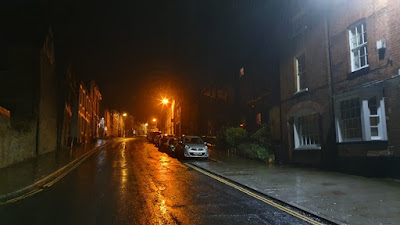 |
| September 2023 |
You might notice it's raining in that photo. Hard. I got soaked. The stupid thing is, I already had a perfectly decent picture of Old Street. A lovely picture with a nice blue sky taken on Sunday afternoon at 4.30pm. Old Street hasn't changed since 1983, I think even the lamp posts are in the same position. Then I went to the pub. Then I went and had a curry. Then, full of delicious curry and two pints of Cobra, I decided it would be a really good idea to walk back to Old Street and grab a night shot. It would be more atmospheric and in line with the original picture. Drizzle was falling. I tried to ignore the way the drizzle was turning into rain, and then the rain was turning into heavy rain. Walking back through the quiet streets darkened my mood and turned it increasingly maudlin. It was something to do with the weather (and beer), and the dark streets (and beer) and the quiet (and beer). My nostalgia populated Ludlow with imagined ghosts and everything took on a heightened significance. Even the fact that I was trying to stand in the same place as the person who took the original photograph of Old Street seemed to echo with meaning. I was in a soppy mood. The beer, the curry, the nostalgia, the rain, the dark and empty street, and the sense of occasion all combined, and suddenly made me think it would be appropriate to say out loud "rest in peace Roger and Oli." So I did. Nothing mystical happened. It just rained some more and I was drenched by the time I got back to the Wheatsheaf.
1/2 King Street, Ludlow, Shropshire
Ground zero. CRASH moved into its new office in August 1984 although the magazine kept the PO Box 10 address on the masthead for General Correspondence until issue 12, the January 1985 issue. I've subsequently learned, through Nathen Jones' post on the CRASH Facebook group, that the King Street landlord was the father of Andy Onions of Realtime Software. Ludlow really is a small town. The Ludlow Civic Society stuck a blue plaque on the side of King Street, quite right too. Alas, it was covered by scaffolding when I passed.
When CRASH moved into King Street they only rented the top two floors, the first floor already had a sub-tenant. A company that made educational software. They must have moved out not long after Newsfield moved in because their adverts in 1984 carry a Hayling Island address.
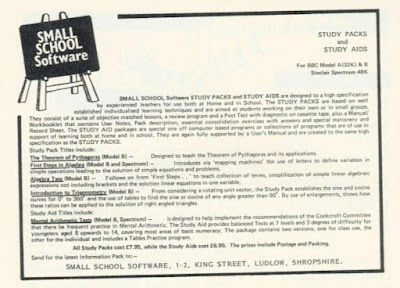 |
| ACORN USER October 1983 page 102 |
This, as with Old Street, was my second attempt at a picture. I took the first one on Sunday afternoon and decided later that I didn't much like it. Once I got back to the Wheatsheaf I sat downstairs for a bit, nursing a pint and half listening to a pub quiz. (What was the first food eaten in space? Which country is home to the tallest building?). I made a few notes and tried to make sense of my strange mood, and then I reviewed the photos I'd taken earlier in the day. For some reason I decided all the pictures of King Street were rubbish and I deleted them. Then I went to bed so I never did find out if it's true or false that Santa Claus has his own postcode. I walked back to up Broad Street on Monday morning after a fortifying Wheatsheaf breakfast. I'd mastered Ludlow's parking app and had a little spare time before I had to leave at 10am. I walked round King Street and the Market, enjoying the brisk morning air and watching the town wake up and open up. The place had been so empty and gloomy the night before, it was lovely to see it full of life. King Street is pretty but narrow and it was difficult to get the building in shot. In the end I had to duck into the doorway of the shop opposite before I was satisfied. I don't know why there's bunting across the street. I didn't tell anyone I was visiting.
 |
| September 2023 |
I like to offer value for money so this is the view round the back of King Street. I can't remember why I ended up walking round there but I've taken the photo so I feel obliged to use it. I was really surprised to see how close the offices were to St Laurence's Church. It must have got noisy at bell ringing time.
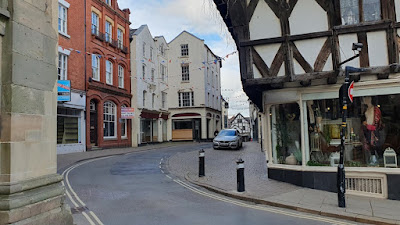 |
| September 2023 |
Sir John Betjeman described Ludlow as "probably the loveliest town in England," and he should know. The narrow streets proved a challenge for running a magazine. The entire staff would be assembled to form a chain and shift magazines from the delivery lorry on the street to the offices. The CRASH History revealed the full horror:
Newsfield unloading sessions became a fraught business, a battle against time and the inevitable intervention of the traffic warden.
Eventually a real fight did ensue with Ludlow's solitary traffic warden, a moment of sublime looniness when the large ex-policeman warden, driven mad by our constant blockages, pinned Oliver Frey to Victoria Wine's wall and threatened assault before several bemused Newsfield witnesses. Ludlow now has two traffic wardens - is this progress or retaliation?
I don't propose to go into the whole history of CRASH, et al. There's no point. If you don't know it, it's well documented elsewhere. A terrific place to start is CRASH's own history printed in 1987 as the magazine approached its fourth birthday and 50th issue. It's revealing and surprisingly blunt and honest at times, and it covers the growth of Newsfield and its triumphs and failures. I love it. CRASH knew its readers were as interested in the process of putting the magazine together as they were about games. These kind of glimpses behind the curtain were catnip to me. There's also a brilliant 20 minute documentary on YouTube with interviews with Roger Kean, Oliver and Franco Frey, Matthew Uffindell
CRASH Online also carries an extract from the Newsfield liquidators report in 1991. It's a good summary of the corporate history but also gloomy because the fact that it's a liquidators report tells you how the story ends. I'm intrigued by this line:
With two libel cases in progress, the shareholders decided under advice from the company's auditors to restructure the Newsfield operations under a group of companies in order to protect unaffected parts of the business from potential claims. Newsfield Publications Limited acted as the holding company, while Newsfield Limited and any other existing and future companies would become fully owned subsidiaries.
Two libel cases? I know about the SINCLAIR USER injunction over the UNCLEAR USER spoof in the August 1985 issue but I don't thinks that's what is being discussed here. If you'd like to know more about the UNCLEAR USER legal battle then check out Reheated Pixels' excellent video on YouTube. I'm pretty sure the libel cases are not related to UNCLEAR USER because Newsfield Publications Ltd (company number 01881558) was set up seven months earlier, on 30th January 1985. Given the timing, I wonder if these libel cases relate to CRASH's five page article about the bankruptcy of Imagine, which was printed in the Christmas special. There's a mysterious comment in the February 1985 issue editorial that seems relevant:
My article on Imagine in the Christmas Special certainly stirred up a hornets nest of comment, much of it from the city of Liverpool, and ripples are still spreading outwards as I write.
If anyone has any more information, or has access to a legal database of old cases, I'd be really interested to hear from you.
[SMALL UPDATE: 21/6/24. Going back through the CRASH 2018 annual, from Fusion Retro's excellent CRASH relaunch, I found this in Roger Kean's introduction:
However, more to the point, the first occasion for exhibiting my journalistic boldness before a member of the Bar was after the KERRASH! news item we published in the August 1984 issue about the demise of Imagine Software... It had unflattering things to say about Imagine's three key directors and they sued Newsfield, CRASH, et moi for defamation of character. As things transpired, the threat fizzled out after a brief revival following the detailed article on the subject in the 1984 Christmas Special.]
CRASH was established and successful enough by 1985 that it made sense to create another magazine along the same lines. The result was ZZAP!64, covering the booming Commodore 64 market. CRASH printed an advert in the April 1985 issue which includes a mocked up cover for issue one. The artwork used on the mock up would finally see print on the cover of issue three.
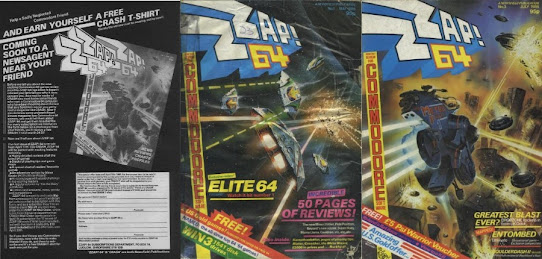 |
| Left to right: ZZAP!64 advert, issue one cover, issue three cover |
The appointment of Chris Anderson as ZZAP editor was a surprise because he'd butted heads with Roger Kean a year previously. CRASH printed a profile of programmers Steve Turner and Andrew Braybrook in issue two; this profile was written by Andrew Hewson of Hewson Consultants who published Steve Turner and Andrew Braybrook's games. Chris Anderson picked up on this and the magazine he edited at the time, PERSONAL COMPUTER GAMES, printed an anonymous article in its April 1984 Whispering Horace gossip column:
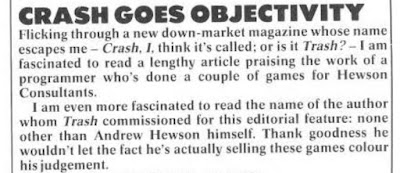 |
| PERSONAL COMPUTER GAMES April 1984 page 24 |
The item clearly touched a nerve, possibly because Roger Kean thought the accusation undermined the credibility he wanted for CRASH. He responded in a touchy fashion in issue 4's editorial:
Flicking through the pages of a cynically up-market publication, whose name escapes me for the moment -Personal Computer Games I think it's called- I was fascinated to read a snippet of gossipy inconsequentially which suggested that CRASH is a down-market magazine which cares nothing for objectivity. This because of an article on programmer Steve Turner written by Andrew Hewson (Turner's games are published by Heweon Consultants) This point may have had some validity had we hidden the writer's identity.
What's surprising about the piece in Personal Computer Games (April 1984) is that another computer title should obviously feel so threatened by CRASH as to resort to cheap smear tactics like this, and it wouldn't even rate a mention it these tactics were only confined to the scribblings of an unimportant hack.
Unfortunately they have extended to advertisement executive of PCG spreading falsehoods in public, a matter I can't go into here, unfortunately.
Unfortunately they have extended to advertisement executive of PCG spreading falsehoods in public, a matter I can't go into here, unfortunately.
Fortunately this was all water under the bridge and Chris Anderson was appointed editor of ZZAP!64. The magazine was run from Yeovil, of which more later, with the layout and administration carried out in Ludlow. I don't know how this was supposed to work in 1985 and after three issues the Newsfield management clearly agreed. ZZAP's editorial was moved to Ludlow over Chris Anderson's objections and Roger Kean used a blunt phrase when talking to outofprintarchive.com: "It was the first major, sad decisions, but we removed Chris and transferred everything to Ludlow." Ouch. Chris Anderson went on to found Future Publishing which he sold to Pearson PLC for £52.7 million in 1994. Needless to say, he had the last laugh.
Now there were two magazines in the King Street offices, and by October 1985 there was a third. The three main computer formats in the UK were Sinclair, Commodore, and Amstrad, so it made sense to launch AMTIX. And then there were four magazines. The end of 1986 saw Newsfield launch its most ambitious title yet, a proto lads-mag called LM. It was a bold gamble that failed.
47 Gravel Hill, Ludlow
269,000 copies of LM issue zero were printed for distribution with CRASH, ZZAP, and AMTIX. I liked it enough to pick up issue one but I quickly drifted away. Did I even buy issue two? I honestly don't remember. I wanted to support the magazine but I didn't engage with it, I think at 15 I might still have been slightly too young for the contents or, alternatively, I was just too laser focused on computer games. Looking at the index for issue one now, I can appreciate that it was trying to reach out to a broad base. There's an interview with Paul McGann which catches him at a unique time post The Monocled Mutineer but pre Withnail and I; there's other interviews with Pierce Brosnan and Emlyn Hughes; and articles about Birmingham, domestic violence, The Prisoner, and jumble sales; and reviews music, films, video, fashion, and books! Then there's the cover(s).
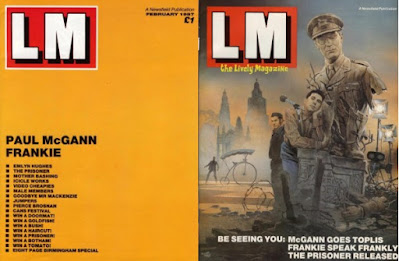 |
| LM issue one front and inside cover |
LM had an unusual dual cover. The plain orange outer cover which opened to reveal a more standard Oliver Frey painting. I like it. It would have stood out like a beacon on the shelves. But, I'm not in publishing. Julian Rignall, who wrote for ZZAP from issue one and would become editor from December 1987 recalled on Twitter:
Oh man. I remember seeing that and thinking WTF. As you can imagine, it was an absolute sales disaster.
The dual cover format was changed for issue two, which suggests the editorial team realised almost immediately that it really didn't work. The front cover was now split between the monochrome block and more traditional artwork, which then opened and revealed a full page modified picture inside. This probably works best on issue four where the cover picture shows four blokes having a great time on the booze and the inside cover shows the aftermath. Issue four was the end. Roger Kean, who had returned to edit CRASH, wrote an obituary in the June 1987 issue which was more of a broadside at the marketing industry:
The directors of Newsfield... committed the company to launching an entirely new type of youth magazine.
Fed up with the accepted pap of existing periodicals, Newsfield tried to devise a magazine which would encompass every aspect of life, involve the readership as much as the computer titles did and present itself as a long and good read every month- From its plethora of early working titles, it became known as LM.
Sadly, the experiment has ended. The fifth issue of LM has not been printed. The magazine has closed and its talented and devoted editorial team have gone their separate ways, I said 'ended' - LM did not fail, but market forces prevailed against it. Advertising agencies and their clients failed to see the impact LM was going to have on the traditionally fractured and difficult 'youth' market. The magazine was referred to as 'too widely targeted'; translated, that means it covered so much ground in its editorial that advertisers couldn't see who was going to buy it The belief that people aged between 15 and 25 require magazines of a narrow scope and preferably with very few words which skate right over the top of a subject, hardly touching its depths at all, continues.
Advertisers thought LM would confuse potential readers and so no-one would buy it. They were wrong. Taking into account the increases in monthly sales from the first issue, LM issue five would have enjoyed sales probably in excess of 60.000, and I'm confident it was easily set to top 100,000 before the end of the year.
LM had to close because Newsfield is not a huge conglomerate with limitless funds, and the company could not wait any longer for advertising revenue to catch up with LM's monthly costs. As I write, there is still a hope that another publisher will buy the title. But whatever happens, the spirit of LM will not die. It lit a flame under the precious notions of youth publishing, and pointed a finger in a different, more vital direction. Hopefully someone will learn a few lessons from it, so that we may look forward to magazines with guts in their bellies instead of guff.
This was Newsfield's second failure of 1987. In February Newsfield had taken the decision to close AMTIX after 18 issues because the advertising revenue wasn't there to support it. Now LM had gone as well after losing nearly £20,000 every issue. A year later the Newsfield internal newsletter Newsfeel reported the total losses as £300,000 (that's about £935,000 today) a disastrous amount. Again, Julian Rignall was bluntly honest on Twitter and estimated the losses even higher:
[Newsfield] had massive potential... until Oli and Roger lost about £450,000 launching LM, a magazine that neither advertisers nor readers were interested in - and that the Newsfield staff all thought was a huge mistake. After that, it was downhill until the company went bankrupt in 1991.
And this is where I move on to the bit that's difficult to write. When I'm putting these posts together I'll write little notes for myself. It's usually mundane reminders about something I want to cover, like the mystery two libel actions I mentioned earlier, but here I've added a note that says "be honest about Roger and Oli." It's clear they weren't always great managers.
35 years ago, this was the final edition of ZZAP! I produced. After 39 issues, a combination of increasingly toxic management and a strong desire to write about the emerging new consoles that excited me resulted in me moving on from Newsfield and starting anew at CVG
That's what Julian Rignall wrote on Twitter. Reading it crystalised something I'd been wondering about for years. I've already mentioned the Newsfield History printed by CRASH, and how much I loved it, but even as a self-absorbed and CRASH obsessed teenager I noticed it talked a lot about bad arguments and personnel disputes, and Newsfield staff who just leave suddenly, and how it gave a sense that the senior management team spent a lot of their time flitting from magazine to magazine, taking decisions, and not allowing their editors to edit.
The entry for May 1986 details a row between Roger Kean and contributor Robin Candy, who edited the popular playing tips section over whether it should include a picture of Robin. He didn't want one, Roger insisted and:
There was an argument in the middle of the office and it was decided not to use Robin any more.
This also brings to mind Roger's flat comment about the firing of Chris Anderson as ZZAP!64 editor.
[CRASH] was really a magazine without an editor, which is a bit like a ship without a captain, with no-one to guide it. [Publishing Executives Editor] Graeme Kidd's time was shared all three computer magazines, and CRASH seemed to lose some of its direction.
Roger Kean returned to King Street and once again took up editorship of CRASH, the magazine he had helped found. Lee [Paddon] and Hannah [Smith] left in the reshuffle, and Graeme Kidd was moved to Gravel Hill to edit LM.
It would be wrong to publish many of the confidential details, so suffice it to say that there were problems with the way THE GAMES MACHINE was run by the two editors (fortunately, they didn't show in the finished product), and shortly after the completion of its first issue Graeme Kidd and Gary Penn were asked to leave the company... the only long-term casualty of the Newsfield's internal changes was [monthly column] Fear & Loathing; John Minson, who had been a personal friend of the dismissed Graeme Kidd, was no longer happy with writing for CRASH.
There are other examples but I'm not interested in digging up dirt. I think I'd previously rationalised this as examples of being in a high pressure workplace but actually over a couple of days of reflection I've realised that Oliver and Roger were real, fallible people. It's helped me ground my reaction to being in Ludlow where I had a disconnect between the town of my nostalgia and the reality of a place where people are just going about their lives.
I don't know how permanent any of these arguments were. Graeme Kidd stayed in Ludlow and become a popular and well-loved mayor who did a lot of work to promote the town via the Ludlow Food Festival before his too early death in 2009. June 1987 saw Robin Candy return to CRASH. I'll end this section with one last tweet from Julian Rignall:
We were always friends. They were just terrible mangers and could be very difficult to work with. After Newsfield collapsed and they realized what had gone wrong, they became a lot more philosophical about their mistakes.
CRASH, ZZAP!64, AMTIX, and now LM. 1986 saw the company expand to around 60 staff with the launch of LM, too many to fit into King Street:
Newsfield had been searching for over a year for premises big enough for expansion, but there was nowhere available in Ludlow. So a large semidetached house similar in size to the King Street headquarters was purchased and converted to offices for administration and LM editorial. This was on Gravel Hill, Ludlow (once misspelled 'Grovel Hill' - nicknamed 'The Grovelry' since it was where the pay cheques were issued).
Gravel Hill was as far as I got outside Ludlow town centre. LM editorial, administration, advertising, the mail order business (which was still running), and subscriptions were all based there. It's not far from King Street, about half a mile, but it's not ideal to start dividing a company into silos. The search for more suitable office space would drag on for a couple of years. The second issue of NEWSFEEL covered the story in the Christmas 1988 issue and gave two options. Option 1: Find a bigger building.
which would cut down on communication problems both on a face-to-face basis and over the currently unsatisfactory internal phone system.
The problem was, there was no suitable building in town. Was it unthinkable for Newsfield to move out of Ludlow?
Option 2: Build somewhere:
Council planners have undertaken to try recruiting a property developer to build Newsfield an office block, probably on the projected Sheet Road Estate extension.
Option 1 would finally be taken up in a couple of years but the story gave me a new address on which to focus.
58 Broad Street, Ludlow
Space was leased on the top floor of 58 Broad Street and the advertising department moved there in 1987, freeing up room at Gravel Hill, but as NEWSFEEL noted: "the interdependence of all editorial and production facilities means that the space freed at Gravel Hill is of no use in easing restrictions at King Street. The Newsfield Liquidator's report goes further in describing some of the problems the company faced:
The physical separation of departments had a detrimental effect on the flow of information and created inter-company factions and divisions which at one point in time culminated in a complete breakdown of activities within the company.
That line about "a complete breakdown of activities within the company," boggles my mind. I know what it says but what does it mean?
58 Broad Street is now an Indian restaurant. What was I going to do? Not eat curry in a building which had been partially used by Newsfield 35 years previously? It was brilliant. 10/10. Will definitely eat there again the next time I'm in Ludlow. A bonus, for me, I was seated by the window so I could watch the world go by while I ate; normally I'm placed in some shadowy corner like the Elephant Man's less attractive brother.
 |
| CRASH December 1988 page 150 |
Newsfield recovered from the losses caused by LM and had a second go at a big mass-market magazine. MOVIE was aimed at the expanding sell-through VHS market, and launched in October 1988 seven months before EMPIRE from rivals EMAP. MOVIE, like LM, needed a London office and, like LM, it didn't establish itself quickly enough to avoid cancellation, and closed after issue 7. The company launched a few more magazines; a horror and science-fiction magazine called FEAR; a role-playing magazine called GAMES MASTER INTERNATIONAL; a console magazine called RAZE. None of them achieved the sort of mass-market success Newsfield needed. The company was trapped relying on CRASH and ZZAP!64 to fund the bulk of the business but those two magazines were largely locked in to fading computer formats. Cover mounted tapes had always been a good way to boost circulation with a unique collection of demos, or unpublished games, or even special seasonal bonuses but by the end of the eighties they became the main event, a cover tape with a magazine attached. Or in CRASH's case, a pamphlet. The magazine shifted to monthly cover tapes in June 1989 and the cost of sourcing back catalogues games had an immediate effect on the magazine. The May 1989 issue ran to 92 pages, June 1989 was 36. That was the low point, after that the magazine never dropped below 52 pages. ZZAP! didn't suffer quite so badly and tended to bounce along with a page count around 60-70.
 |
| EAGLE 30 June 1990 page 15 |
Behind the scenes, the all-important advertising revenue continued to fall as the market moved away from 8-bit computers. As the liquidator's report explains:
Advertisement income dropped alarmingly at the beginning of 1990 and then again in 1991 to such an extent that comparisons of the October issues of Zzap! showed the 1991 figures to be only 25% of those of 1990.
Case Mill, Temeside, Ludlow
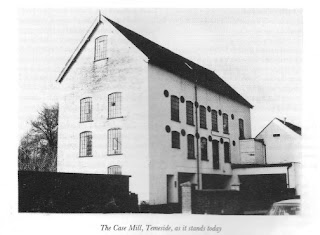 |
| LUDLOW HERITAGE NEWS April 1988 page 6 |
Newsfield finally found a building big enough to hold the entire company. A converted mill on the bank of the river Teme in the industrial zone of Ludlow. It was at the end of my walk around town. I'd taken a loop round the outside of the castle, then back down through Broad Gate towards the Ludford Bridge which leads on to the top of Temeside. It's odd, in such a pretty town, to suddenly be walking past MOT garages and an absolutely enormous place which advertised itself as "the home of the hedge cutter." As I came round the end of the hedge cutter factory I saw the tall blank wall of the building which forms the end of Case Mill. The whole building is pretty big, about 50 meters long, and I didn't do a good job of getting a photo. I should have walked further down and taken a second photo of the other end. But I didn't. Fortunately the Ludlow Civic Society came to my rescue with a picture showing the other end of the building as it looked in 1988.Case Mill is where the Newsfield story comes to an end. The move took place in March 1990 and the company kept going until September 1991. Roger Kean told outofprintarchive.com what happened next:
It had been clear for months that Newsfield was suffering, but to be frank, the company's financial operations had never kept pace with the magazine production side in terms of new technology. Too much management information was "back of envelope" stuff — one reason for appointing Jonathan Rignall (Julian Rignall's younger brother) as managing director. He quickly rendered all the paperwork systems to a series of Excel files and the spreadsheet he produced told the story. Unless there was a rapid reversal of fortunes, Newsfield could not live in safe solvency beyond March 1992.... And so the directors reluctantly took advice and agreed to a voluntary liquidation, which was set for September 1991.
Europress Impact
There was an afterlife. Jonathan Rignall made contact with publishers Europress who funded a buyout of Newsfields assets. The new company called Europress Impact kept 19 jobs going and resumed business in Case Mill. Newsfield had been working on two magazines SEGA FORCE AND NINTENDO FORCE, and these finally saw publication as Europress Impact titles. Europress was supposed to be the parent company to Europress Impact where Roger Kean, Oliver Frey, and Jonathan Rignall were directors. Roger Kean recalled to outofprintarchive.com that Europress were more hands on than expected and imposed a series of controversial decisions.
There was an afterlife. Jonathan Rignall made contact with publishers Europress who funded a buyout of Newsfields assets. The new company called Europress Impact kept 19 jobs going and resumed business in Case Mill. Newsfield had been working on two magazines SEGA FORCE AND NINTENDO FORCE, and these finally saw publication as Europress Impact titles. Europress was supposed to be the parent company to Europress Impact where Roger Kean, Oliver Frey, and Jonathan Rignall were directors. Roger Kean recalled to outofprintarchive.com that Europress were more hands on than expected and imposed a series of controversial decisions.
First, CRASH was handed over to EMAP. Yes, it's true. SINCLAIR USER won. Roger Kean recalled:
In fact, it wasn't even a sale, Europress swapped Crash for a defunct EMAP title they wanted to incorporate into one of their magazines. It was a travesty which left everyone in Ludlow speechless.
 |
| CRASH April 1992 page 12 |
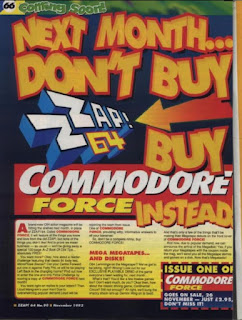 |
| ZZAP!64 November 1992 page 66 |
ZZAP!64 lasted until November 1992. Europress decreed the magazine be relaunched as COMMODORE FORCE to bring it in line with the other Europress Impact titles; SEGA FORCE, N-FORCE, and AMIGA FORCE. CRASH was gone. ZZAP!64 was gone. Jonathan Rignall left next over a difference of opinion, and then Oliver Frey and Roger Kean resigned over another difference of opinion with Europress. Once the pair had left, Europress put Impact into administration in March 1994.
Over at the spectrumcomputing.co.uk/forum PeteProdge uncovered this lovely story in the Chart Music podcast (Chart Music #73 starting at 19:51). It's about the last Newsfield (well, alright, Europress Impact) Christmas Party. Which includes the phrase "Oli, absolutely off his box with his shirt completely undone, grabbing the mike of the DJ and screaming 'everyone -dance, dance for your magazines!' "Followed by: "And in six weeks time the entire company would fold because the financial director had embezzled half a million pounds out of the company."
Ludlow Miscellaneous
Bits of Ludlow kept cropping up in CRASH and ZZAP. Here, for example, are the loonies from Design Design firing rubber bands out of the CRASH office window and inconveniencing passers by.
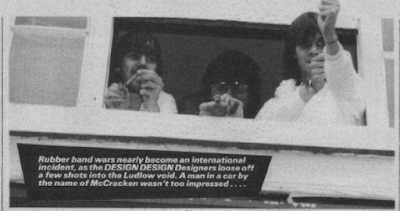 |
| CRASH November 1985 page 40 |
The following year (September 1986 page 73), the CRASH team actually managed to get properly outside and trekked all the way down Market Street to Ludlow Castle to capture this picture of programmer Dave Perry being menaced by Mikro-Gen's Wally Week in the old doctored photo style.
Alas, when Costa Panayi and Luke Andrews of Vortex came to Ludlow the following month, to show off their new game Revolution, CRASH was still knackered from the previous month's walk and couldn't manage more than a 40 foot stagger from their office to get a picture of the pair propping up the columns of the Buttercross (October 1986 page 110).
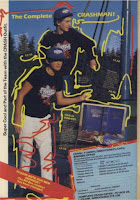 |
| CRASH July 1987 page 98 |
 |
| CRASH May 1984 page 107 |
Last stop on this Newsfield tour of Ludlow is the location of the atmospheric vérité photos used to illustrate a GAMES MACHINE article about software pirates (December 1988 page 95). Is it possible to identify the location of the lovely old wall in front of which a couple of Newsfield staffers stood and pretended to be pirates? I think it is. The pictures in the article have all been artfully cropped but the one on the contents page is full height and includes a Police sign which was removed from all the other images. Ludlow Police Station is on Lower Galdeford Street and a look at the area on Streetview reveals a couple of likely wall candidates on both sides of the road. The Police Station itself seems to have been redeveloped around 2000-ish and I suspect the wall was remodelled along with the Police Station.
If you want a good look at Ludlow in 1984 then point your attention to the BBC adaption of the Tom Sharpe novel Blott on the Landscape. It used a lot of locations in and around Ludlow including Broad Street and the High Street. The riot at the end of episode one was filmed in Ludlow but don't go looking for the big building used as the location for the planning enquiry. That's Ludlow Market Hall and by 1984 it was in a bad way. It was demolished in 1986 and that's where the open air market is today.
1 Church Terrace, Yeovil, Somerset BA30
The editorial address for the first three issues of ZZAP!64 was different. The new magazine was based in Yeovil in Somerset, 140 (ish) miles from Ludlow.
 |
| September 2023 |
I had trouble finding Church Terrace. Google seemed reluctant to tell me its location. After a little prompting it directed me to St John the Baptist Church in the centre of Yeovil and I wandered up and down the parade of buildings which faced on to the churchyard and tried to work out why I couldn't find number one. The answer was, I was on Church Path not Church Terrace but Google refused to direct me towards Church Terrace. I knew it existed, I'd seen pictures of it online. In the end I followed Church Path round the other side of the building and spotted some white buildings on the far side. I walked across the grass, being careful not to tread on any graves, and found myself looking down into a row of white terraced houses. Then I walked down the steps onto Silver Street and immediately saw the Church Terrace sign which had eluded me.
That London
Advance Works, 44 Wallace Road, London N1
The 44 Wallace Road address had been appearing in Newsfield magazines since issue one, under the name of a company called Scan Studios were credited with colour origination. Colour was a really complicated thing to put in magazines in the eighties. Colour laser scanners were basically unaffordable so instead of doing the work in-house Newsfield outsourced the process of scanning pictures and and turning them into magenta, cyan, yellow, and black separations for printing. I can only assume that Advance Works was the name of the business centre where Scan Studios was based and when the search was on for offices for LM it was simplest to start at an address which the Newsfield directors already knew.
Here's the thing. I can't find it. I can find Wallace Road, it's right next to Canonbury overground station. The house numbers in Wallace Road run consecutively. I can find 43 Wallace Road. I can find 45 Wallace Road. And in between those two houses is nothing. Is that nothing in the middle 44 Wallace Road?
Google turns up records for Advance Works Canonbury on everything from a 1914 Trade Directory to the address where a Prison Reform Trust report was printed in 2000. It clearly existed but unless it was a treehouse, it ain't there now. I've fired off an email to the Islington Local History Centre, so lets wait and see what they say. The one thing that makes he reasonably sure I'm looking in the right place is that gate in the middle of the picture. It doesn't appear to go anywhere. Unfortunately my investigations were limited by a bloke sitting in a car outside number 45. There's a limit to how much I can poke around without looking like your friendly neighbourhood burglar.
 |
| February 2024 Not pictured 44 Wallace Road, or is it? |
[Update 20/3/2024] It was. That nothing in the middle is all that's left of 44 Wallace Road. The Layers of London website has an overlay for OS Maps (1940s-1960s) which shows the space in between 43 and 45 Wallace Road used to be a driveway leading down to Advance Works, a large building next to the railway line. The site is long cleared and replaced by new builds which are joined to Wallace Road by a street called Heaven Tree Close that runs along the side of the railway line.
Research House, Frazer Road, Perivale
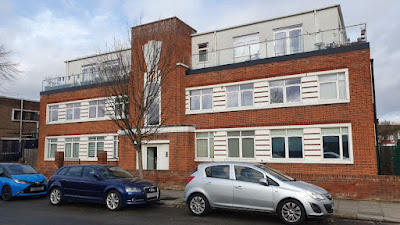 |
| February 2024 |
Research House has the advantage of being easy to find and still obviously existing. The office got a write-up in the second issue of NEWSFEEL.
As well as pointing me in the direction of Perivale, this story taunts me by mentioning the LM editorial office at Wallace Road:
Previously several members of the LM magazine editorial were in London, using rooms at Scan Studios in Canonbury, together with Thalamus before the software house moved to Aldermaston.
[1] You may remember a PC GAMER article about getting troublesome games to work on your PC. You may also remember a boxout attached to this article about the "reality" of working for a technical support line. This article was credited to Agent Orange, who was me under a cunning pseudonym. The boxout was rubbish and I'm really sorry.
[2] Actually, it turns out the newsagent was called NSS. Accuracy in all things.
[3] I wonder if Oliver Frey was responsible for naming Rod Bellamy after British comic artist Frank Bellamy.



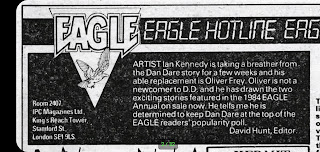
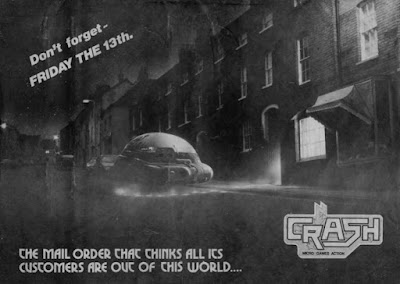

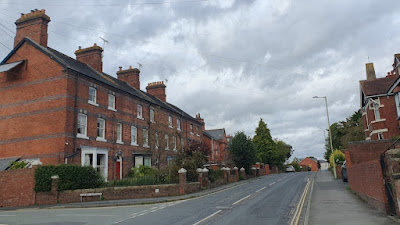
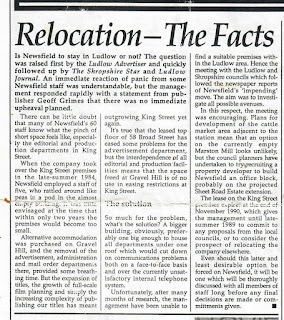
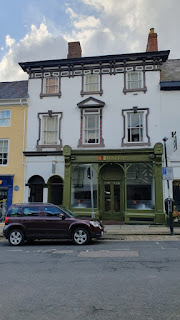

.jpg)

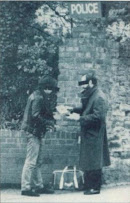








fascinating read; I knew a bit about the Freys' backstory with Newsfield and Europress already, and as a Patreon supporter of the Chart Music podcast was pleasantly surprised to hear them come up via Al's work for Mega Machines on my original listen of the recent episode, now linked both here and on the SC forums. good to have some of the blanks filled in with this :)
ReplyDeleteA great read, but a sad one given the passing of both Oli and Roger, and in a lesser way the passing of Newsfield and CRASH.
ReplyDeleteI have to say it's a surprise that your dream of working on a computer game mag didn't pan out, as you have tons of writing talent and obvious passion for the subject. I'm a smidge younger than you but our experiences overlap; my first CRASH was issue 27, the one with the toastrack 128K as a spaceship on the cover. I wanted to work for them too ;)
So yes, thanks for a great read. You convey so much, not just factual information but also the human and emotional side of things. For some reason Newsfield just hits harder than any softco ever could. I hope that Oli and Roger knew something of the impact they had on so many people, and how much they were loved.